It may seem like I’ve been on an eagle tangent lately, but as I try to keep this weekly feature timely, that’s just what has been flying in front of my camera-lens combo regularly. Few people would apologize for that kind of eagle luck, but I like to highlight a variety of birds in this photography article. That said, gosh did I have some fast-paced fun a couple times last Thursday afternoon when I teamed up with my friend Andy to photograph Trumpeter Swans that have been wintering along the Pelican River.
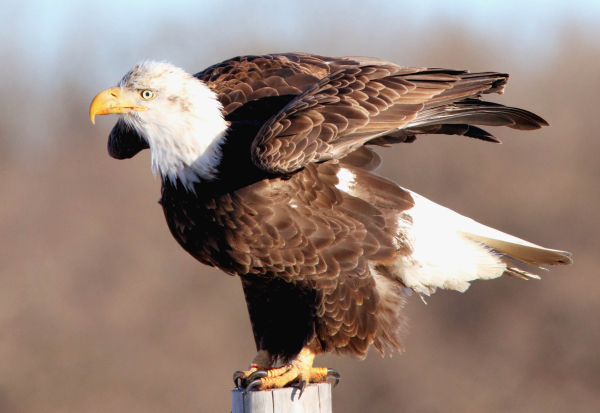
After landing on a low post adjacent to the road, the most trusting Bald Eagle in Minnesota regained its balance as it folded its wings and lowered them to its side. The opposite colors of white and dark brown make getting just the right lighting and color balance difficult, with either the white becoming overly bright or the dark brown approaching black (600mm zoom lens, f-8 aperture, 1/1000 shutter speed, 800 ISO).
We found plenty of swans as we circled a familiar area from Pelican Lake to Cormorant Lake and back, looking for open water areas in the ice-topped lakes and connecting rivers where swans and Canada Geese were sometimes positioned. The ‘problem’ was that the swans weren’t in the expected locations where we would be graced by afternoon sunshine for photographs, and the Trumpeters we did find were on the opposite side of the open waters. But there was another photo opportunity – Bald Eagles.
I encountered 12 Bald Eagles throughout my day, on the way to Minnesota lakes country and in the area southwest of Detroit Lakes. Two of the Bald Eagles were at separate nest sites on my way to Andy’s home, and it was interesting to see 2 perched in a shoreside tree just across the little river on the edge of Andy’s property. With no swans on the river at that time, Andy and I decided to do a search of the area for swans and eagles, which went reasonably well for swans, but as far as photography opportunities, there was just one: A pair of Trumpeters that was resting on the ice of a large lake.
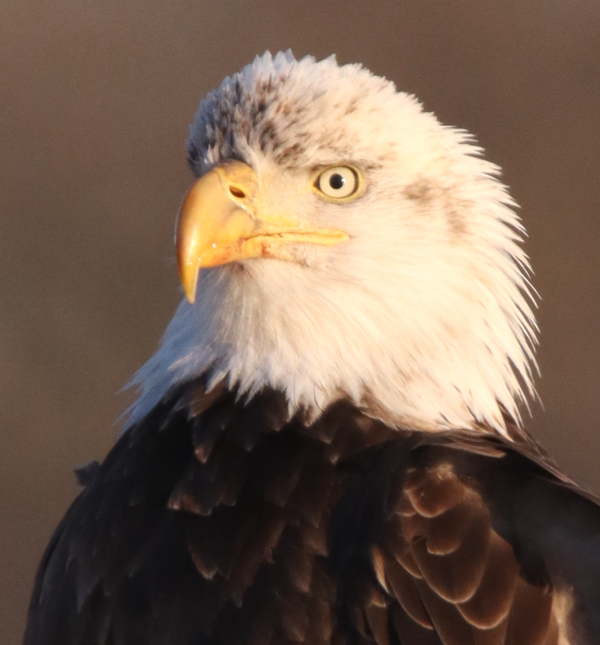
The chance to take sharp portrait images of the same eagle showed it still had a little brown color among the white feathers on its crown, suggesting it may be approaching its first nesting season (600mm zoom lens, f-7 aperture, 1/1000 shutter speed, 800 ISO)
|
As we headed back to Andy’s home, toward the end of prime sunlight, I could see the tiny image of an adult Bald Eagle perched on a low fencepost adjacent to the road almost a mile ahead. I pointed it out to Andy and as we cruised closer, Andy saw there were 2 more eagles on the ground next to the road that were feeding on the remains of a roadkill. I checked my rearview mirror, and although we usually had the quiet rural road to ourselves, a car turned in behind us and essentially kept me from stopping safely to photograph. So we motored forward, expecting to see the eagles flare up before us.
Instead, the 3 Bald Eagles kept their cool as we drove within a few feet of them, as did the car behind us. Now that level of trust was unexpected, but appreciated. I turned off the road a half-mile ahead, letting the car pass and turning back toward the eagles. They were undaunted, and there were no other cars to be seen along the mile-plus of open view.
The next key to getting a successful photo op would be to drive past the eagles, to get on the west side of their position with the sun at my back. As I cautiously passed the eagles it was amazing to drive so close past the trio of eagles, which had Andy quite excited, especially when 1 of the eagles on the ground raised up in flight as we passed. When I thought we were in the right spot I made an almost U-turn after double-checking for other vehicles – none. I turned off the engine and focused on the perched eagle first, then on the eagle feeding on the ground, and switched back and forth while checking on the other eagle in flight that might return. Woo, that’s when you know you are in the midst of something special.
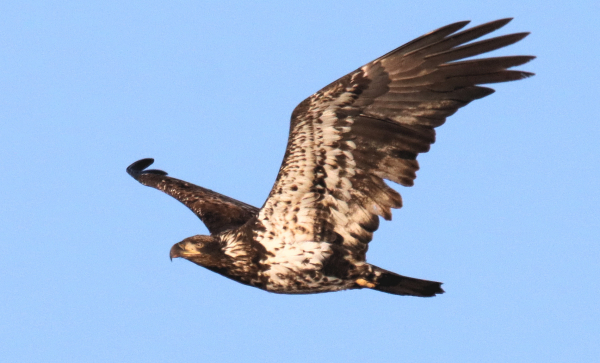
. The chance to photograph 1 of the 6 eagles in flight was especially enjoyable, partly because it was the only yearling Bald Eagle among the crowd (500mm zoom lens, f-8 aperture, 1/3200 shutter speed, 800 ISO).
Andy called out that an eagle just flew over the hill to our left, so that was another photo option – eagle number 4. While I was photographing, Andy noted that another eagle was perched on the edge of a nearby wooded area, and using binoculars he announced it was a young eagle without a white head and tail. It would be a plus to get a chance to photograph that bird, which turned out to be a yearling Bald Eagle.
About a minute later we saw the young eagle fly across the roadway and fly toward us at a bit of an angle to the left. In a flash I switched the focus of my camera lens toward the beautifully marked eagle as it winged ever-closer. “Here we go,” I said as I began taking photos. What fun to have this chance in fine late afternoon sunlight, especially because this was the only none-adult Bald Eagle I would see that day.
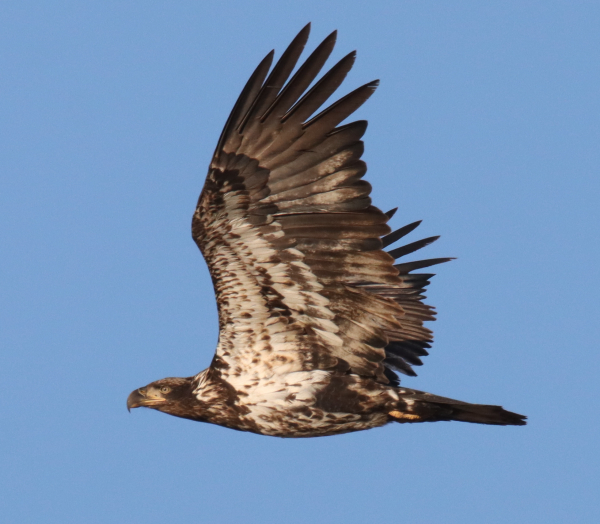
The young eagle flew closer until it was broadside to our position. It’s markings were particularly beautiful as they were highlighted by the late afternoon sunlight (500mm zoom lens, f-8 aperture, 1/2500 shutter speed, 800 ISO).
We took a little more time to photograph the perched adult and the feeding adult, and as I photographed, Andy called out the final eagle sighting – 6 in all, seemingly all attracted to this essential food source. Above all, it was especially surprising to witness the trusting nature of the Bald Eagle perched on the low fencepost so near the road. It never flinched, except that after joining 2 other eagles to feed, when a car drove by on the opposite side of the road all 3 eagles flew up, and while the others flew to perch in nearby trees, the “post eagle” simply hopped back to its low fencepost. That’s when I had a chance to get a little different photograph of it as it settled into position, bent forward while folding and lowering its wings to its sides.
I took another 40 seconds to take a few final portrait photos of the big Bald, and especially appreciated how it had its characteristic white head feathers raised apart, adding some character to the head and shoulders images I was taking. With that, we drove on, caught our breath, and appreciated the excitement of the moments getting into position and photographing the big raptors, confident the outlying eagles would return to their feeding session after we passed over the hill to the east.
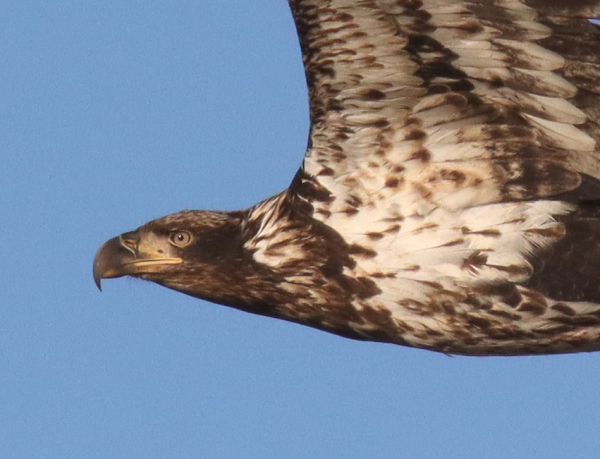
By cropping this photograph, and thereby enlarging it more, it is possible to see more details in the coloration of individual feathers as well as the yearling’s overall appearance (500mm zoom lens, f-8 aperture, 1/2500 shutter speed, 800 ISO).
|
Andy hadn’t seen an eagle up to that point Thursday, so to see the group of eagles zeroed in on a food source, and responding to our approach in a remarkably trusting way was rewarding. That eagle action was obviously a lot different from our summer and fall loon cruises that Andy captains, and while we look forward to the return of Common Loons, the eagles and swans were an exciting early spring focus last week.
So often, it’s a fast-paced chance encounter that creates an exciting photo opportunity and unparalleled photo action that works its way into my weekly Bird Photography articles, but that’s a fairly regular part of birding. Birding adds a level of excitement to our lives, whether it’s a new bird at your feeding station, or a 6-pack of Bald Eagles zeroing in on a roadside attraction – you never know what’s down the road or around the corner. Andy and I planned this afternoon photo session around Trumpeter Swans, but the end result turned out to be much different.
The next morning Andy texted me 3 cell photos he took of the swans in the open water near his house, and I wrote back, “Timing is everything.” Birds are relatively unpredictable, even when they were fairly predictable day after day for weeks before. But that’s part of the excitement of birding too, the unpredictability of what will transpire during birding episodes. Maybe it’s the hope of encountering certain birds too, the anticipation of what you might find that inspires us to enjoy birding again and again – while trying to get new photos of birds that show their beauty, elegance, intensity, and strength as they survive, and hopefully thrive. Enjoy searching for the birds of early spring, along with birds that surprise you along your daily way!
Article and Photographs by Paul Konrad
Share your bird photos and birding experiences at editorstbw2@gmail.com